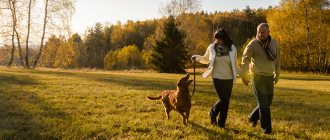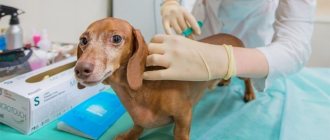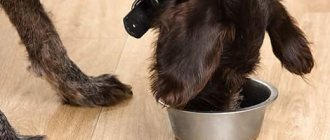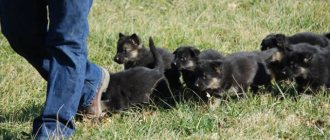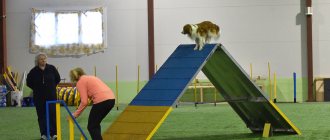In most cases, a walk with a four-legged pet comes down to quickly relieving yourself without maintaining safety or maintaining cleanliness. Because of this, animals lack socialization and activity, and all other members of society suffer from their aggression and massive pollution of lawns. All these problems cannot be ignored. To solve them, owners need to not only familiarize themselves with the basic rules, but also remember 2 very important points: how many times a day and how long to walk the dog.
Why are four-legged animals taken for walks?
In addition to relieving yourself, daily walks help solve several other important tasks. These include:
- communication with other four-legged animals and people;
- satisfaction of the hunting instinct;
- maintaining good physical shape;
- an opportunity to release pent-up energy.
Neglecting regular walking is fraught with attacks of sudden aggression, disobedience and excess weight gain. Animals that rarely go outside are more likely than others to attack strangers and damage their owners’ things.
How to walk your dog correctly
Walking your dog properly means giving it the opportunity to satisfy its physiological needs, go for a run, socialize with other dogs, and communicate with its owner without being distracted by others. It would be a good idea to repeat a few basic commands or practice performing new ones. For this, naturally, the pet should receive a reward.
If you include all the necessary points, then walking the dog will be correct. The pet will be able to fully communicate with its relatives and receive “information” about the environment, and perceive a variety of smells.
A sign of a good walk is your pet's sound sleep. There is no need to rush and complete all the points in the proposed plan. You can divide this into morning and evening walking. It is necessary to maintain a balance.
The dog owner must create several routes along which to walk the pet. To successfully plan your day, you need to time the routes. During your morning walk, you can choose a short path that takes from 15 to 20 minutes. In the evening, it is recommended to choose a route at least 1 hour long.
A full walk must necessarily include the movement of the animal without a leash. The dog should walk freely most of the time. Otherwise, the dog’s motor activity and physical activity are reduced.
A healthy dog should jog to be in good physical shape. This type of running is necessary to maintain excellent physical shape. You can only let your dog off the leash if the pet is well trained in commands and obedience.
The dog may not be taught such commands as “Barrier!”, “Fetch!”, “Down!”, but it is necessary to teach the pet the important commands “Come to me!” and “Stop!” To get quick results from training, it is recommended to take the puppy to a specially equipped training area. This will allow you to avoid a large number of mistakes and teach your dog to flawlessly follow commands.
You need to train your dog to walk without a leash only after it has learned the command “Come to me!” It is mistakenly considered that the command is completed if the pet responds to the name. The command is considered completed only if, after voicing it once, the dog changes the trajectory of its movement and runs up to the owner. The animal should not circle around the owner, but only come close and stop the movement. In such accessibility that the owner can easily attach the leash to the collar.
At training grounds, dogs are trained not only to run up to the owner at the first call, but also to sit down immediately. The command “Stop!” is necessary. An urgent need to know this command arises in cases where unforeseen situations require the owner to approach the dog, and not vice versa. An example is when the owner sees danger approaching the animal and in such cases it is better for the dog not to move and stay in place.
Only after the dog has learned the command “Stop!” and “Come to me!”, you can practice walking an animal without a leash. Conditioned reflexes, which include issuing commands, can fade over time. Dog handlers recommend regular practice throughout the animal’s life.
After your dog completes any command, you must reward it with a treat or praise. This will strengthen the bond and similar behavior. The animal learns to follow its owner, who, in fact, is the main one when passing the route. It is necessary to establish dominance over your dog. Only in this way will the animal obey and listen to its owner, feeling the leader in him.
It is important to note that when people appear on the horizon, you must always call your pet to you and take it on a leash, no matter how affectionate and friendly the dog is.
A dog can frighten a passerby, especially one suffering from neuroses and fear of animals. It will be difficult for the owner to work through the situation if the dog lunges at a passerby who is intoxicated.
How many times a day should you walk your dog?
Age directly affects how often you need to walk your dog. The younger she is, the more energy and strength she has.
With a puppy
The puppies are walked 4-6 times a day for 10-15 minutes. This amount is explained by the fact that small pets do not yet know how to control their bladder. Frequent walking makes toilet training easier. The most optimal time to go outside is immediately after a night's sleep and before it, as well as after each meal.
If you have enough free time, walk your pet every 2-3 hours. This way he will get used to the toilet faster. After this, the breaks are increased, reducing the number of walks to 3-4 times.
With an adult dog
Adult healthy animals are walked 2-3 times a day. Their bladder can easily withstand a break of 10-12 hours. But, if your job allows you to do this more often, then it is better to increase the number of trips outside. Extra physical activity will benefit both you and your pet.
Tips for novice dog owners
Unfortunately, it often happens that when buying a dog, family members almost fight for the opportunity to walk with the newly acquired Rex or Jack. And after some time, the enthusiasm diminishes considerably. Not everyone is ready to change their daily routine for the sake of their little brother: get up earlier, go to bed later, spend several hours every day on those same walks in parks and squares.
Photo from the site www.vseodetyah.com
Relatives are beginning to increasingly complain about how often they need to walk the dog and they are unlikely to be able to do it regularly. Therefore, they do not allow their children to have a pet, knowing that the dog will not receive proper care from them anyway. But, if you still believe that you can become a responsible person, then our advice will help you.
Before you go for a walk, put a collar, leash, and muzzle on your dog. Over time, the animal will begin to realize that if you pick up the leash, it’s time to go for a walk. By the way, the use of characteristic phrases also plays a role, so pull the leash towards yourself and say loudly and clearly: “Go for a walk!”
Photo from the site forum.ngs.ru
Continue talking to your pet throughout the route. If the dog plays around or behaves aggressively, use a stern, commanding voice. If the dog is obedient and friendly, do not skimp on praise: “well done,” “good,” etc.
Remember that the collar should be fastened tightly, but not tightly. There should be 1-2 fingers between the product and the dog’s neck.
Decide in advance whether the dog will be on your right or left side. It is not recommended to change sides from walk to walk. You must decide which side is more comfortable and convenient for you to be in, so that if something happens, you can pull the dog away. If your pet constantly rushes to the side, you need to learn the command with him: “Near!”, while pulling the leash so that the dog is in the indicated place.
When you're teaching a young dog to take daily walks, be sure to reward him from time to time. But do it in such a way that the pet understands that he received a treat because he behaved well, for example, he did not pull the leash too much towards himself and immediately received a treat. If you don’t have anything tasty with you, then just pet the dog, so he will feel your love.
Photo from www.yaplakal.com
Try to change your route regularly. Firstly, you yourself will discover new places. Secondly, the dog will be able to remember as many ways to the house as possible and, if it ever gets lost, it will have a better chance of finding its home. But do this only after the dog has learned the basic route. Otherwise, she will be nervous and worry that something has gone wrong.
Don't walk in hot weather. In summer, the asphalt gets very hot and your pet’s paws will be hot. Before you go for a walk: test the asphalt with your palm. This way you will protect your friend from burns. Dogs are also susceptible to heatstroke, so you need to be very careful during summer walks.
Owners of very active dogs always carry a water spray bottle with them. To easily cool down your pet's ardor on occasion.
Photo from tsamax.su
How long should you walk your dog?
The average walking time for adult animals is 1.5-2 hours. But how long you can walk your dog is influenced by two more important factors: breed and weather conditions.
Depending on the breed
It is important to consider the size and purpose of the breed. The larger and more active your pet, the more time you should devote to it.
The recommended time and immediate program for the upcoming route for different breeds is as follows:
- Toy breeds and companion dogs. Yorkies, Pekingese and Pugs need 1-1.5 hours a day. They easily get used to the tray, and to warm up their paws, periodic runs around the apartment are enough for them. Such dogs are walked at a calm pace so as not to tire them ahead of time.
- Herding, guard, hunting, service and sledding. All these breeds are working breeds. They are walked 2-4 hours a day. Regular outings are complemented by active activities: joint jogging, cycling and training on dog parks.
- Fighting ones. This group should be considered separately. The main goals of walking here are socialization and education. The more time you devote to training, the better. If any problems arise, contact your dog handler immediately.
Please note that fighting and working dogs are not suitable for workaholics. Lack of activity has a detrimental effect on their psyche. A bored animal may begin to attack its owners or dig tunnels in the sofa.
Depending on weather conditions
Not only the duration of going outside, but also what time to walk the dog depends on weather conditions. In summer, it is better to go out in the morning or late afternoon, when the sun has not yet risen or is already beginning to set. But in frost, slush and wind, it is recommended to reduce the total walking time - so that the animal does not have time to catch a cold.
Particular attention should be paid to small and hairless breeds. They quickly overheat and constantly freeze. To maintain a comfortable body temperature during the cold season, they need warm overalls.
Disposal of animal excrement and other waste
How long should you really walk your dog?
By law, a dog owner must clean up his dog's waste. However, difficulties arise when implementing the law, since this type of garbage must be disposed of separately from household waste.
Boxes designed for disposal of animal excrement
This means that throwing feces into a regular container placed outside is prohibited. In this regard, special boxes with corresponding signs appear in large cities, but so far this is rare.
Special walking situations
In addition to age, breed and weather conditions, several more factors need to be taken into account: pregnancy, lactation, estrus period and the presence of diseases.
Little puppies
Children are taken outside after receiving all required vaccinations. Until this moment, they are walked only on private territory in the courtyard of their own house.
Pregnant and lactating bitches
During pregnancy, it is recommended to reduce activity and go outside more often (3-4 times a day). The uterus pressing on the bladder increases the urge to urinate.
If your pet has already given birth, then during the lactation period it is better to walk her in a special overall. It will protect your nipples from damage.
Bitches in heat
Females in heat attract males, so try to walk in secluded places. Leave an hour earlier or later than other dog walkers to keep unwanted contact to a minimum.
Be sure to monitor your pet's well-being. If she looks tired and refuses her usual route, feel free to go home.
Animals with diseases
Recommendations depend on the diagnosis. Each disease has its own limitations:
- Infections. Strict ban on contact with other animals. The walking time depends on the well-being of the infected person.
- Pathologies of the musculoskeletal system. Restrictions apply to jumping, running and any intense exercise.
- Diseases of the gastrointestinal tract and genitourinary system. In case of incontinence, animals are walked 4-6 times a day.
- Cardiovascular diseases. Fresh air is good for the heart, so walks at a leisurely pace are welcome. Light activity is also allowed, but at the first sign of discomfort it must be reduced.
The postoperative period should be highlighted separately. Here you need to rely on medical recommendations.
Volvulus is a risk for a dog if you walk after eating
Volvulus is a risk for your dog if you walk after eating
Volvulus is a condition common to deep-chested breeds such as Greyhounds, German Shepherds and Labradors, but can also occur in other dogs. So be careful.
Some of the factors that can trigger the disease are anxiety, worry, stress, rigorous training and eating a large diet. Walking with vigorous exercise and then returning to a filling meal is a potentially dangerous combination that can cause volvulus.
If your dog is very hungry after a walk, he will most likely eat the food quickly, which can cause volvulus.
Intestinal volvulus is not just banal gastritis, but something more serious and dangerous, or rather, even deadly for your dog.
Watch for the following signs and symptoms:
- Your dog may be very agitated, tense, or anxious shortly after walking and eating.
- She may have a bloated stomach due to gas buildup in the stomach.
- The dog may struggle to have a bowel movement, sometimes even whining in pain.
- It may be unpleasant and painful for the animal.
- Possible vomiting of white foam or non-productive vomiting (when there is an urge, but nothing comes out)
This is a very painful and not a good situation for your dog.
Therefore, to avoid such a problem, it is necessary to maintain a 2-hour pause after eating, before an active walk with games and training.
Also, veterinarians recommend not feeding dogs large portions. Also, teach your pet to eat slowly. Provide plenty of water and allow your pet to rest after feeding to allow the stomach to slowly digest the food.
Further information from the website of the leading UK clinic thevet.co.uk here is a link to the original volvulus (GDV information in English)
How does volvulus develop: phases of pathology?
| PHASE 1 | The stomach begins to expand and twist | Anxious, restless, pacing, drooling, swollen/painful abdomen | Call your veterinarian for immediate advice. If possible, take your dog to the vet immediately. | The dog can recover from this phase with a slight release of pressure from the veterinarian. |
| PHASE 2 | The blood supply to part of the stomach is cut off, the twisting intensifies, and the dog goes into shock. | Very restless, whines and breathes heavily, drools profusely, stands with his legs apart and his head hanging down, his gums are dark red. | Take your dog to the vet as quickly as possible. | At this point, your veterinarian may need to perform surgery to correct the twists in your dog's abdomen and place your dog on an IV. |
| PHASE 3 | The shock is now very strong, the dog will suffer from further internal problems | The animal is unable to stand, the abdomen is very swollen, shallow breathing, pale gums | Take your dog to the vet as soon as possible. | The veterinarian will attempt to provide life-saving first aid and surgery |
Rules for walking
The rules for walking four-legged animals are regulated by Federal Law No. 498. The latest amendments regarding the safety of others and maintaining cleanliness came into force on January 1, 2022.
Safety Compliance
In public places, animals are strictly walked on a short leash. If the dog belongs to a potentially dangerous breed (fighting), then a muzzle is added to the mandatory equipment.
Walking without a leash is allowed only in special areas (far from children's and educational institutions) or outside the city, where there are no other people. Please note that this rule applies not only to large but also small breeds. A Chihuahua is unlikely to harm a passerby, but it will easily suffer if it frightens a person with its sudden barking.
Keeping it clean
Another important point is waste disposal. Always carry bags and a dustpan with you to clean up after your pet. It is recommended to dispose of the waste itself in special boxes, but if they are not available, a regular trash can will do. In Moscow and St. Petersburg, throwing organic waste into ordinary trash cans is prohibited.
Taking care of your dog's health
Consider the weather conditions before going outside. In rain and frost, the animal needs warm clothes, and in hot weather - a bottle of water. If you live in the city center, pay attention to dog boots. They will protect against reagents.
An equally important point is education. Teach your pet commands that prohibit picking up questionable foods from the ground. A well-timed “Ew” can save a life.
In addition to the ban, three more commands are useful: “Near”, “To me” and “Sit”. Thanks to them, you can always attract attention or calm down a playful dog.
Which dog breeds need to wear a muzzle?
How many times a day should you feed a domestic cat?
Small dog breeds, such as Yorkies or Spitz dogs, can be walked without a muzzle. This article applies to potentially dangerous dog breeds, which, according to the new law, are interpreted as breeds that pose a potential threat to human health and life.
Full list of dog breeds that pose a threat (according to Government Decree No. 974 dated July 29, 2019):
- Akbash;
- wolf-dogs and wolf-dog hybrids;
- ambuldog;
- North Caucasian dogs;
- American Bandog;
- Pit Bull Mastiff;
- Brazilian Bulldog;
- gul-dong;
- Alapaha purebred bulldog (Otto);
- bandog;
- bully kuta.
The list is expected to expand, since it is planned to include a total of about 70 different breeds.
Which dogs can you refuse a daily walk with?
Owners of small and dwarf breeds may refuse daily walks. These pets include Japanese Chins, Chihuahuas, Pomeranians, Shih Tzus and other babies. All of them easily get used to the tray and quite quickly spend the energy accumulated during the day after several laps around the room.
This group also includes larger representatives - pugs. These four-legged animals have very low activity. They are so lazy that you have to work hard to get them outside. The pug is walked only to maintain normal weight.
Serving Size
You should also consider the size of your food when planning your outing. If your pet has just had a snack, then you should go for a walk after 20-30 minutes.
If the portion size was large, it is recommended to take a longer break, which we wrote about above.
You can take your pet for a walk for 20-30 minutes before eating. However, if the dog is overweight, then the walk should be calm, otherwise the animal may have heart problems. Upon returning from a walk, give the animal water and leave a gap until the next meal.
Typically, dogs are overweight due to food being available at all times and not being active enough to burn it off. It is best to stick to a strict schedule. You may not be able to resist those melting eyes that can make you feel guilty if you don't share tidbits sometimes. Tidbits are fine, but don't overfeed your dog, especially with treats.
The benefits of walking
Walking is beneficial not only for four-legged animals, but also for their owners. By neglecting them, you miss out on a lot of opportunities.
For pet
The main benefits for the dog were described earlier. Regular walking socializes, satisfies innate instincts, strengthens the immune system and has a beneficial effect on physical fitness.
For the owner
The points about strengthening the immune system and physical activity are also relevant for owners. Walking in different weather conditions strengthens the body, has a beneficial effect on the musculoskeletal system and the heart, and also reduces the risk of developing varicose veins and obesity.
It is equally important that it is easier for dog lovers to make new acquaintances, and frequent contact with the four-legged dog strengthens its attachment. The last point makes the training process easier.
Why some owners don't walk their animals enough
There are quite a few reasons for this, but most often the problem lies in the lack of free time and simple laziness. If you are not ready for early rises, walks immediately after work and going outside in any weather, consider purchasing a more unpretentious pet.
Conclusion
Unlike cats, dogs not only can, but also need to be walked. Lack of physical activity has a detrimental effect on their physical and mental health. Before you get a four-legged pet, make sure that you can handle its maintenance and care.
Do you like the article? 304
What does an optimal walk include?
A proper walk, during which the dog can meet all its needs, includes the following activities:
- Relief of need.
- Sniffing the territory and putting your marks on top of others.
- Exercise stress.
- Mental load.
Sniffing the territory
Part of the time during walking must be spent moving together along some route. Not only will this keep your dog occupied, but it will also provide some exercise.
At the same time, try to change your route every walk. If you often walk the same roads, you will notice that your dog becomes less and less interested in his surroundings and sniffs the bushes less often. Nothing changes, and the animal becomes bored. If you avoid the usual route for at least a couple of days and then return, it will be much more interesting for the dog.
If possible, change your walking routes. Firstly, it will be more interesting for the dog to walk, and, secondly, it will be able to get acquainted with new situations.
Exercise stress
It is important to provide the dog with adequate physical activity, which will help relieve the tension that has accumulated while being at home without much movement.
Many owners believe that it is enough to let their pet play with other dogs as exercise. This is incorrect - from such communication the dog will not lose much energy, but will get into an excited state, which he will then lose at home. And the owner will complain that the dog behaves badly and destroys the apartment, but in fact he himself is to blame for such behavior.
So how to walk correctly? It’s quite difficult to give specific recommendations on how much you need to move: for some, it’s enough to run after a ball a little, and for others, you need to run for an hour after a bicycle. The level of stress depends on the dog's breed, health status, age and other factors. One way or another, it is desirable that physical activity is initiated by the owner and not chaotic.
If your dog likes to interact with his friends, let him play with them for a while, and then take him aside and spend time doing something together.
Mental load
In addition to physical exercise, it is important to provide the dog with mental stress - after all, previously animals regularly had to use their intelligence when “searching for prey.”
Intellectual tasks are especially relevant for owners of active dogs, who often complain that no matter how much they run around the park, no matter how much they throw the ball, the dog still remains full of energy. To solve this problem, it is worth replacing part of the physical activity with mental activity. Choose interesting intelligence exercises (for example, search games or shaping) that will force the dog to think and find solutions.
15 minutes of mental stress for a dog is equivalent to 1.5 hours of physical activity.
During estrus and pregnancy
There are no restrictions on the time pregnant dogs can spend outside in the park or during estrus. Only if there are health problems and the veterinarian does not recommend pregnant dogs to walk a lot. It is not advisable to play active games. Also, if you need to climb the stairs home, and the dog is a dachshund, then it is better to carry the animal in your arms.
During the heat period, you can walk and play as usual. You should not allow contact with male dogs at this time. You may not keep track and then unwanted puppies will be born.
